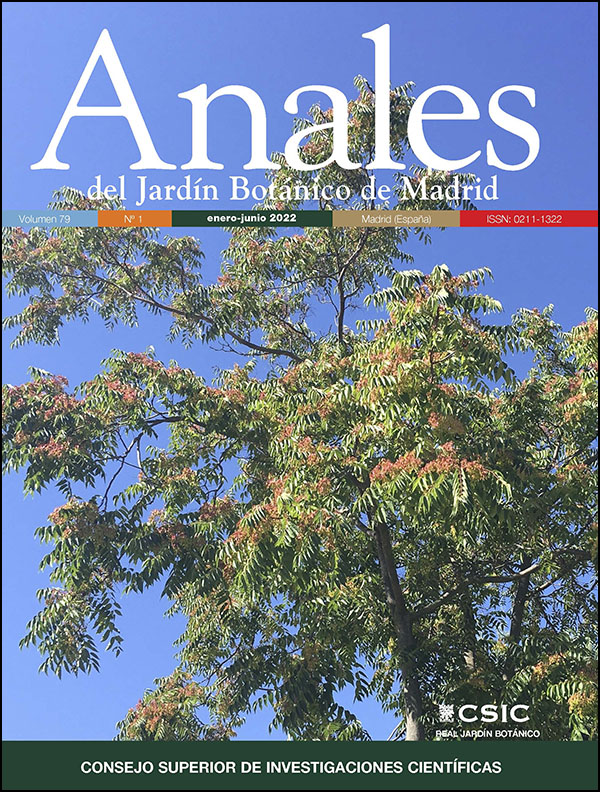A taxonomic treatment of Drypetes calvescens and a new endangered species from the western Congolian swamp forest, D. palustris sp. nov. (Putranjivaceae)
DOI:
https://doi.org/10.3989/ajbm.2615Keywords:
Central Africa, conservation status, endangered species, new species, taxonomy, swamp forestsAbstract
We publish in this article a new species of tree of Drypetes (Putranjivaceae) from the Democratic Republic of the Congo and Republic of the Congo, D. palustris, which occurs in the Western Congolian Swamp Forests ecoregion. It is known from eight gatherings and we compare it with the species with the most similar morphology, D. calvescens, of which we have studied 51 gatherings collected in Central Africa. A taxonomic treatment of both species, including their detailed descriptions, typification of their names, a comparative table summarizing their main morphological differences, an illustration and information about their habitat and distribution are provided. A provisional IUCN Red List assessment shows that D. palustris is Endangered and D. calvescens is of Least Concern.
Downloads
References
Bamps P. & Bouharmont J. 2010. Charles Marie Evrard (1926-2009). Plant Ecology and Evolution 143: 243-245. https://doi.org/10.5091/plecevo.2010.412
Barberá P., Quintanar A., Harris D.J. & Stévart T. 2021. Drypetes calvescens. The IUCN Red List of Threatened Species 2021: e.T174410896A174513635.
Cheek M., Ndam N. & Budden A. 2021. Notes on the threatened lowland forests of Mt Cameroon and their endemics including Drypetes burnleyae sp. nov., with a key to species of Drypetes sect. Stipulares (Putranjivaceae). Kew Bulletin 76(2) [unpaged]. https://doi.org/10.1007/s12225-021-09947-2
Dargie G.C., Lewis S.L., Lawson I.T., Mitchard E.T., Page S.E., Bocko Y.E. & Ifo S.A. 2017. Age, extent and carbon storage of the central Congo Basin peatland complex. Nature 542: 86-90. https://doi.org/10.1038/nature21048 PMid:28077869
ESRI. 2000. Arcview 3.2. Environmental Systems Research Institute, Inc., Redlands, California.
GeoCAT. 2020. Geospatial Conservation Assessment Tool. Royal Botanic Gardens, Kew. http://geocat.kew.org
Govaerts R., Frodin D.G. & Radcliffe-Smith A. 2000. World Checklist and Bibliography of Euphorbiaceae. Royal Botanic Gardens, Kew.
Grace D., Khan M.S., Friesen K. & Ata A. 2016. Antimicrobial compounds from Drypetes staudtii. Chemistry & Biodiversity 13: 913-917. https://doi.org/10.1002/cbdv.201500298 PMid:27288642
Harris D.J., Barberá P., Nguema D. & Quintanar A. 2021. Putranjivaceae Endl. in M.S.M. Sosef & al. (eds.), Flore du Gabon 57: 107-173. Margraf Publishers, Weikersheim.
Harris J.G. & Harris M.W. 1994. Plant Identification Terminology. An Illustrated Glossary. Spring Lake Publishing, Spring Lake.
IUCN Standards and Petitions Committee. 2019. Guidelines for Using the IUCN Red List Categories and Criteria. Version 14. Prepared by the Standards and Petitions Subcommittee. IUCN, Gland, Switzerland; Cambridge, United Kingdom.
Johnson S.D., Griffiths M.E., Peter C.I. & Lawes M.J. 2009. Pollinators, "mustard oil" volatiles in flowers of the dioecious tree Drypetes natalensis (Putranjivaceae). American Journal of Botany 96: 2080-2086. https://doi.org/10.3732/ajb.0800362 PMid:21622327
Pax F.A. & Hoffmann K. 1922. Euphorbiaceae-Phyllanthoideae-Phyllantheae in Engler H.G.A. (ed.), Das Pflanzenreich IV. 147, XV (Heft 81): 1-349. Wilhelm Engelmann, Leipzig.
Pole M. 1991. A modified terminology for angiosperm leaf architecture. Journal of the Royal Society of New Zealand 21: 297-312. https://doi.org/10.1080/03036758.1991.10420828
Quintanar A., Harris D.J. & Barberá P. 2020. A new species of Drypetes (Putranjivaceae) discovered by J. Léonard in the Democratic Republic of the Congo. Plant Ecology and Evolution 153: 312-320. https://doi.org/10.5091/plecevo.2020.1709
Quintanar A., Barberá P., Nguema D., Medjibe V., Goodwin Z.A., Onana J.M., Ndolo Ebika S.T., Ewango C.E.N., Moutsamboté J.M. & Harris D.J. 2021a. Lurking in the Shadows: A New Species of Drypetes (Putranjivaceae) from Central Africa Hiding in Forest Plots and Herbaria. Novon 29: 14-23. https://doi.org/10.3417/2020637
Quintanar A., Harris D.J. & Barberá P. 2021b. The Genus Drypetes (Putranjivaceae) in Liberia: An Annotated Checklist with a New Species, D. liberica. Annals of the Missouri Botanical Garden 106: 47-63. https://doi.org/10.3417/2021622
Radcliffe-Smith A. 1978. Notes on African Euphorbiaceae VII. Kew Bulletin 32: 475-481. https://doi.org/10.2307/4117118
Radcliffe-Smith A. 1987. Drypetes Vahl in Polhill R.M. (ed.), Flora of Tropical East Africa. Euphorbiaceae 1: 88-103. A.A. Balkema, Rotterdam, Boston.
Radcliffe-Smith, A. 2001. Genera Euphorbiacearum. Royal Botanic Gardens, Kew.
Stearn W.T. 1973. Botanical Latin, ed. 2. David & Charles Newton Abbot, London.
Thiers B. 2020 [continuously updated]. Index Herbariorum: A global directory of public herbaria and associated staff. New York Botanical Garden's Virtual Herbarium. http://sweetgum.nybg.org/science/ih/ [accessed 31 Dec. 2020].
Zhang L., Liu P., Sun Y., He Y., Luo N., Chen C. & Li A. 2016. Two new triterpenoids from the leaves and stems of Drypetes cumingii. Chemistry of Natural Compounds 52: 424-426 https://doi.org/10.1007/s10600-016-1664-x
Published
How to Cite
Issue
Section
License
Copyright (c) 2022 Consejo Superior de Investigaciones Científicas (CSIC)

This work is licensed under a Creative Commons Attribution 4.0 International License.
© CSIC. Manuscripts published in both the print and online versions of this journal are the property of the Consejo Superior de Investigaciones Científicas, and quoting this source is a requirement for any partial or full reproduction.
All contents of this electronic edition, except where otherwise noted, are distributed under a Creative Commons Attribution 4.0 International (CC BY 4.0) licence. You may read the basic information and the legal text of the licence. The indication of the CC BY 4.0 licence must be expressly stated in this way when necessary.
Self-archiving in repositories, personal webpages or similar, of any version other than the final version of the work produced by the publisher, is not allowed.















